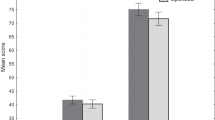Abstract
Introduction and hypothesis
The purpose of this study was to determine if a clean intermittent self-catheterization (CISC) instructional video could improve anxiety in women undergoing prolapse and/or incontinence surgery.
Methods
A total of 199 women were randomized to preoperative CISC video or routine counseling prior to prolapse/incontinence surgery. Patient anxiety, satisfaction, and concerns about CISC were evaluated using the State-Trait Anxiety Inventory-State (STAI-S) and study-specific visual analog scale (VAS) questions at four perioperative time points.
Results
STAI-S and VAS anxiety measures were similar at baseline between groups; no significant differences were seen by group at any time point. STAI-S scores varied considerably over time, with highest scores at voiding trial failure and lowest scores at postoperative visit. Women in the video group had improved STAI-S scores and reported less worry and more comfort with CISC immediately following video viewing. Women with anxiety/depression had higher STAI-S scores at voiding trial failure and discharge and reported less anxiety reduction following video viewing compared to non-anxious/non-depressed peers.
Conclusions
Women undergoing prolapse/incontinence surgery have significant perioperative anxiety, which is exacerbated by voiding trial failure. Preoperative CISC video viewing decreases anxiety scores immediately following viewing, but this effect is not sustained at voiding trial failure. Women with baseline anxiety/depression exhibit less anxiety score improvement after video viewing and have overall higher anxiety scores perioperatively.

Similar content being viewed by others
References
Sutkin G, Alperin M, Meyn L, Wiesenfeld HC, Ellison R, Zyczynski HM (2010) Symptomatic urinary tract infections after surgery for prolapse and/or incontinence. Int Urogynecol J 21(8):955–961
Hakvoort RA, Thijs SD, Bouwmeester FW, Broekman AM, Ruhe IM, Vernooij MM et al (2011) Comparing clean intermittent catheterisation and transurethral indwelling catheterisation for incomplete voiding after vaginal prolapse surgery: a multicentre randomised trial. BJOG 118(9):1055–1060. doi:10.1111/j.1471-0528.2011.02935.x
Sokol AI, Jelovsek JE, Walters MD, Paraiso MF, Barber MD (2005) Incidence and predictors of prolonged urinary retention after TVT with and without concurrent prolapse surgery. Am J Obstet Gynecol 192(5):1537–1543
Hong B, Park S, Kim HS, Choo MS (2003) Factors predictive of urinary retention after a tension-free vaginal tape procedure for female stress urinary incontinence. J Urol 170(3):852–856
Oh SJ, Ku H, Lim SH, Jeon HG, Son H (2006) Effect of ‘centralized intensive education system’ for clean intermittent self-catheterization in patients with voiding dysfunction who start catheterization for the first time. Int J Urol 13:905–909
Kessler TM, Ryu G, Burkhard FC (2009) Clean intermittent self-catheterization: a burden for the patient? Neurourol Urodyn 28(1):18–21
Elkadry EA, Kenton KS, FitzGerald MP, Shott S, Brubaker L (2003) Patient-selected goals: a new perspective on surgical outcome. Am J Obstet Gynecol 189(6):1551–1557
Herrmann KS, Kreuzer H (1989) A randomized prospective study on anxiety reduction by preparatory disclosure with and without video film show about a planned heart catheterization. Eur Heart J 10(8):753–757
Luck A, Pearson S, Maddem G, Hewett P (1999) Effects of video information on precolonoscopy anxiety and knowledge: a randomised trial. Lancet 354:2032–2035
Spielberger CD (1983) Manual for the State-Trait Anxiety Inventory (STAI). Consulting Psychologists Press, Palo Alto
Uebersax JS, Wyman JF, Shumaker SA, McClish DK, Fantl JA (1995) Short forms to assess life quality and symptom distress for urinary incontinence in women: the Incontinence Impact Questionnaire and the Urogenital Distress Inventory. Continence Program for Women Research Group. Neurourol Urodyn 14(2):131–139
Kroenke K, Spitzer RL (2002) The PHQ-9: a new depression and diagnostic severity measure. Psychiatr Ann 32(9):509–521
Folstein MF, Folstein SE, McHugh PR (1975) “Mini-mental state”: a practical method for grading the cognitive state of patients for the clinician. J Psychiatr Res 12:189–198
Williams VS, Morlock RJ, Feltner D (2010) Psychometric evaluation of a visual analog scale for the assessment of anxiety. Health Qual Life Outcomes 8:57
Carr E, Brockbank K, Allen S, Strike P (2006) Patterns and frequency of anxiety in women undergoing gynaecological surgery. J Clin Nurs 15(3):341–352
Logan K, Shaw C, Webber I, Samuel S, Broome L (2008) Patients’ experiences of learning clean intermittent self-catheterization: a qualitative study. J Adv Nurs 62(1):32–40
Farivar S, Liu H, Hays R (2004) Half standard deviation estimate of the minimally important difference in HRQOL scores? Expert Rev Pharmacoecon Outcomes Res 4(5):515–523
Johnston M (1980) Anxiety in surgical patients. Psychol Med 10(1):145–152
Acknowledgements
Janet Catov, Ph.D. for statistical consultation. Charles D. Spielberger, Ph.D. for allowing us to use the State Trait Anxiety Inventory. Mentor Urology, for allowing use and modification of their clean intermittent self-catheterization instructional video.
Conflicts of interest
None.
Author information
Authors and Affiliations
Corresponding author
Rights and permissions
About this article
Cite this article
Oliphant, S.S., Lowder, J.L., Ghetti, C. et al. Effect of a preoperative self-catheterization video on anxiety: a randomized controlled trial. Int Urogynecol J 24, 419–424 (2013). https://doi.org/10.1007/s00192-012-1868-y
Received:
Accepted:
Published:
Issue Date:
DOI: https://doi.org/10.1007/s00192-012-1868-y



